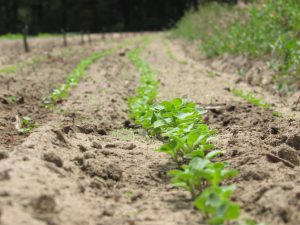For anything growing in the ground, soil is a very important thing. Soil gives plants a place to anchor their roots so they don’t fall over, holds water and nutrients for them to use, and supports a wide variety of living things that contribute to plant growth. Whether you want to grow a lawn, garden, or landscape bed, knowing a little about your soil can make a big difference in the quality of your plants!
There are a lot of terms that relate to soils. Some helpful ones to know include:
-

A chart of soil textures. Credit: Natural Resource Conservation Service
Soil particle sizes / soil texture. A soil that is composed of large particles is sandy, a soil with tiny particles is clayey, and a soil with mid-sized particles is silty. Multiple sizes of particles can mix together to form a soil, which is why you may see soils referred to with terms like, “sandy loam” or “silty clay loam”. This mixture of particle sizes gives a soil its texture.
- Soil acidity / pH. The pH of a soil refers to its level of acidity. The pH scale ranges from 0 to 14. Low numbers mean the soil is acidic, while higher numbers mean it is basic, or alkaline. 7 is neutral, and many plants grow best in a slightly acidic soil (around 6.5). Some plants, like blueberries and azaleas, prefer a more strongly acidic soil (4.3-5.5). If the soil pH is too far from the plant’s preferred level, it may not be able to take up the nutrients it needs even if they are present in the soil. To raise the pH or make the soil less acidic, we can add garden lime; to lower the pH or make it more acidic, we can add sulfur (though this is not as long-term a solution).
- Organic matter. All the living things out there die at some point, and when they do, other living things break them down as food. Fungi, bacteria, tiny insects, and more are all out there working to make sure you aren’t wading through piles of dead things. Instead, all that decomposed and partially decomposed plant (and animal) matter become part of the soil. Organic matter is part of a healthy soil, and helps it hold onto water and nutrients that plants can use.
- Compost. When you make a pile of dead plant matter and help it decompose on purpose, you’ve made compost. By controlling the material you put into a compost pile as well as the amount of water and oxygen it gets, you can speed up the decomposition process and end up with organic matter to use in your garden.
- Mulch. Mulch is any substance that sits on top of the soil. Wood chips, bark nuggets, pine straw, or even synthetic mulches like sheets of plastic are used to help keep weeds from growing and retain soil moisture.
To gather information about the soil, it can be a good idea to do a soil test. Your local Extension office can help you figure out how to do this. Once you do, you’ll receive information on your soil pH, what plant nutrients are in the soil, and recommendations on how much lime and fertilizer you’ll need to add for the year. Test your soil before you add any major amendments such as lime or fertilizer. This will help you add the right amounts at the right time – too much fertilizer, for example, can harm plants or run off into surrounding water bodies, causing environmental damage.
You can find more information on soil testing here, or visit your local Extension office. Soil tests can take up to two weeks to return a result, so plan ahead!
- The Eastern Lubber Grasshopper - June 5, 2025
- Grass is Growing; Time for Mowing - April 30, 2025
- Variegation, Viruses, and You - June 27, 2024

